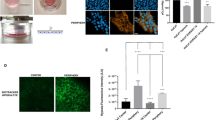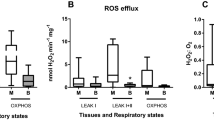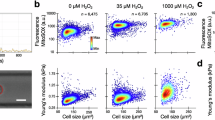Abstract
We recently showed that acidosis is protective during hypoxia and detrimental during reoxygenation. We hypothesized that the detrimental effect of acidosis during reoxygenation was due to a negative effect on mitochondrial function. Human postmitotic NT2-N neurons were exposed to 3 h of hypoxia and glucose deprivation and then reoxygenated for 0, 1, 4, 9, or 21 h. The detrimental effect of acidotic reoxygenation on metabolic activity was evident already after 1 h of reoxygenation, when MTT [3-(4, 5-dimethylthiazol-2-yl)-2, 5-diphenyltetrazolium bromide] reduction (percentage of normoxic controls) was significantly higher in cells reoxygenated with neutral compared with acidotic medium both after acidotic hypoxia (83 ± 26% versus 67 ± 27%, p = 0.006) and after neutral hypoxia (51 ± 12% versus 41 ± 7%, p = 0.005). Hypoxanthine, a marker of cellular energy failure, increased more with acidotic compared with neutral reoxygenation both after acidotic hypoxia (after 21 h: 7.7 ± 2.7 versus 3.1 ± 1.9 μM, p < 0.001) and after neutral hypoxia (10.4 ± 2.6 versus 7.9 ± 2.8 μM, p = 0.001). During hypoxia and reoxygenation, there was an earlier reduction in the activity of complex IV compared with complexes II+III, and the ratio between these complexes fell during the first hour of reoxygenation. The reduction in complex IV activity was alleviated with acidotic hypoxia. Acidosis during reoxygenation, however, had no effect on the activity of either complex IV or complexes II+III. We conclude that acidosis during hypoxia increases neuronal survival and preserves complex IV activity. Acidosis during reoxygenation has an early detrimental effect on metabolic activity, but this is not mediated through an effect on the mitochondrial complexes IV or II+III.
Similar content being viewed by others
Log in or create a free account to read this content
Gain free access to this article, as well as selected content from this journal and more on nature.com
or
Abbreviations
- COX:
-
cytochrome c oxidase
- DMEM:
-
Dulbecco's modified Eagle medium
- LDH:
-
lactate dehydrogenase
- MTT:
-
3-(4, 5-dimethylthiazol-2-yl)-2, 5-diphenyltetrazolium bromide
- NMDA:
-
N-methyl-d-aspartate
References
Almaas R, Pytte M, Lindstad JK, Wright M, Saugstad OD, Pleasure D, Rootwelt T 2003 Acidosis has opposite effects on neuronal survival during hypoxia and reoxygenation. J Neurochem 84: 1018–1027
Rootwelt T, Dunn M, Yudkoff M, Itoh T, Almaas R, Pleasure D 1998 Hypoxic cell death in human NT2-N neurons: involvement of NMDA and non- NMDA glutamate receptors. J Neurochem 71: 1544–1553
Almaas R, Saugstad OD, Pleasure D, Rootwelt T 2002 Neuronal formation of free radicals plays a minor role in hypoxic cell death in human NT2-N neurons. Pediatr Res 51: 136–143
Almaas R, Saugstad OD, Pleasure D, Rootwelt T 2000 Effect of barbiturates on hydroxyl radicals, lipid peroxidation, and hypoxic cell death in human NT2-N neurons. Anesthesiology 92: 764–774
Giffard RG, Monyer H, Christine CW, Choi DW 1990 Acidosis reduces NMDA receptor activation, glutamate neurotoxicity, and oxygen-glucose deprivation neuronal injury in cortical cultures. Brain Res 506: 339–342
Ikebe S, Tanaka M, Ohno K, Sato W, Hattori K, Kondo T, Mizuno Y, Ozawa T 1990 Increase of deleted mitochondrial DNA in the striatum in Parkinson's disease and senescence. Biochem Biophys Res Commun 170: 1044–1048
Parker WD Jr, Boyson SJ, Luder AS, Parks JK 1990 Evidence for a defect in NADH: ubiquinone oxidoreductase (complex I) in Huntington's disease. Neurology 40: 1231–1234
Kruman II, Mattson MP 1999 Pivotal role of mitochondrial calcium uptake in neural cell apoptosis and necrosis. J Neurochem 72: 529–540
Lorek A, Takei Y, Cady EB, Wyatt JS, Penrice J, Edwards AD, Peebles D, Wylezinska M, Owen-Reece H, Kirkbride V 1994 Delayed (“secondary”) cerebral energy failure after acute hypoxia-ischemia in the newborn piglet: continuous 48-hour studies by phosphorus magnetic resonance spectroscopy. Pediatr Res 36: 699–706
Nakai A, Taniuchi Y, Asakura H, Yokota A, Koshino T, Araki T 2000 Secondary mitochondrial dysfunction after transient intrauterine ischemia in the fetal rat brain. J Obstet Gynaecol Res 26: 383–387
Li PA, Kristian T, He QP, Siesjo BK 2000 Cyclosporin A enhances survival, ameliorates brain damage, and prevents secondary mitochondrial dysfunction after a 30-minute period of transient cerebral ischemia. Exp Neurol 165: 153–163
Abe K, Aoki M, Kawagoe J, Yoshida T, Hattori A, Kogure K, Itoyama Y 1995 Ischemic delayed neuronal death. A mitochondrial hypothesis. Stroke 26: 1478–1489
Liu Y, Peterson DA, Kimura H, Schubert D 1997 Mechanism of cellular 3-(4,5- dimethylthiazol-2-yl)-2,5-diphenyltetrazolium bromide (MTT) reduction. J Neurochem 69: 581–593
Saugstad OD 1988 Hypoxanthine as an indicator of hypoxia: its role in health and disease through free radical production. Pediatr Res 23: 143–150
Almaas R, Sundar TB, Rootwelt T, Oyasaeter S, Saugstad OD 1997 Plasma hypoxanthine reacts more abruptly to changes in oxygenation than base deficit and uric acid in newborn piglets. J Perinat Med 25: 353–360
Wiedemann FR, Vielhaber S, Schroder R, Elger CE, Kunz WS 2000 Evaluation of methods for the determination of mitochondrial respiratory chain enzyme activities in human skeletal muscle samples. Anal Biochem 279: 55–60
Birch-Machin MA, Turnbull DM 2001 Assaying mitochondrial respiratory complex activity in mitochondria isolated from human cells and tissues. Methods Cell Biol 65: 97–117
Munnich A, Rustin P 2001 Clinical spectrum and diagnosis of mitochondrial disorders. Am J Med Genet 106: 4–17
Siemkowicz E, Hansen AJ 1981 Brain extracellular ion composition and EEG activity following 10 minutes ischemia in normo- and hyperglycemic rats. Stroke 12: 236–240
Roth SC, Edwards AD, Cady EB, Delpy DT, Wyatt JS, Azzopardi D, Baudin J, Townsend J, Stewart AL, Reynolds EO 1992 Relation between cerebral oxidative metabolism following birth asphyxia, and neurodevelopmental outcome and brain growth at one year. Dev Med Child Neurol 34: 285–295
Tombaugh GC, Sapolsky RM 1990 Mild acidosis protects hippocampal neurons from injury induced by oxygen and glucose deprivation. Brain Res 506: 343–345
Simmonds RJ, Coade SB, Harkness RA, Drury I, Hytten FE 1982 Nucleotide, nucleoside and purine base concentrations in human placentae. Placentae 3: 29–38
Siesjo BK, Bendek G, Koide T, Westerberg E, Wieloch T 1985 Influence of acidosis on lipid peroxidation in brain tissues in vitro. J Cereb Blood Flow Metab 5: 253–258
Berridge MV, Tan AS 1993 Characterization of the cellular reduction of 3-(4,5-dimethylthiazol-2-yl)-2,5-diphenyltetrazolium bromide (MTT): subcellular localization, substrate dependence, and involvement of mitochondrial electron transport in MTT reduction. Arch Biochem Biophys 303: 474–482
Nelson C, Silverstein FS 1994 Acute disruption of cytochrome oxidase activity in brain in a perinatal rat stroke model. Pediatr Res 36: 12–19
Dimlich RV, Showers MJ, Shipley MT 1990 Densitometric analysis of cytochrome oxidase in ischemic rat brain. Brain Res 516: 181–191
Davey GP, Peuchen S, Clark JB 1998 Energy thresholds in brain mitochondria. Potential involvement in neurodegeneration. J Biol Chem 273: 12753–12757
Wagner KR, Kleinholz M, Myers RE 1990 Delayed decreases in specific brain mitochondrial electron transfer complex activities and cytochrome concentrations following anoxia/ischemia. J Neurol Sci 100: 142–151
Taylor RW, Birch-Machin MA, Bartlett K, Turnbull DM 1993 Succinate-cytochrome c reductase: assessment of its value in the investigation of defects of the respiratory chain. Biochim Biophys Acta 1181: 261–265
Author information
Authors and Affiliations
Corresponding author
Rights and permissions
About this article
Cite this article
Frøyland, E., Wibrand, F., Almaas, R. et al. Acidosis during Reoxygenation Has an Early Detrimental Effect on Neuronal Metabolic Activity. Pediatr Res 57, 488–493 (2005). https://doi.org/10.1203/01.PDR.0000155946.82230.2E
Received:
Accepted:
Issue date:
DOI: https://doi.org/10.1203/01.PDR.0000155946.82230.2E
This article is cited by
-
Antioxidant dysfunction: potential risk for neurotoxicity in ethylmalonic aciduria
Journal of Inherited Metabolic Disease (2010)



